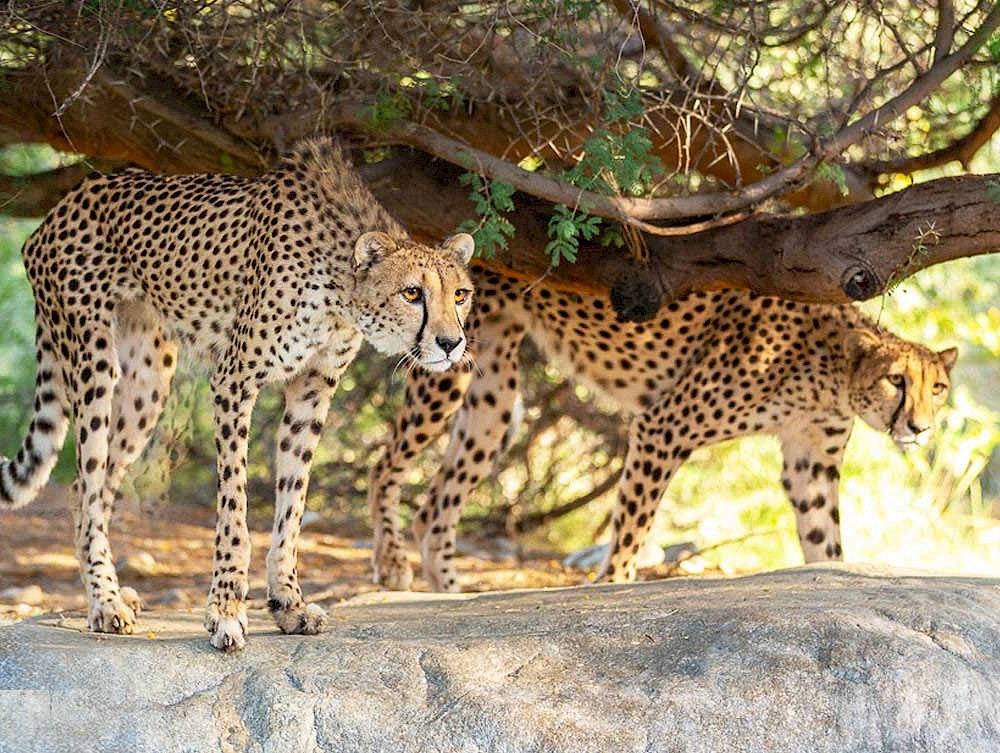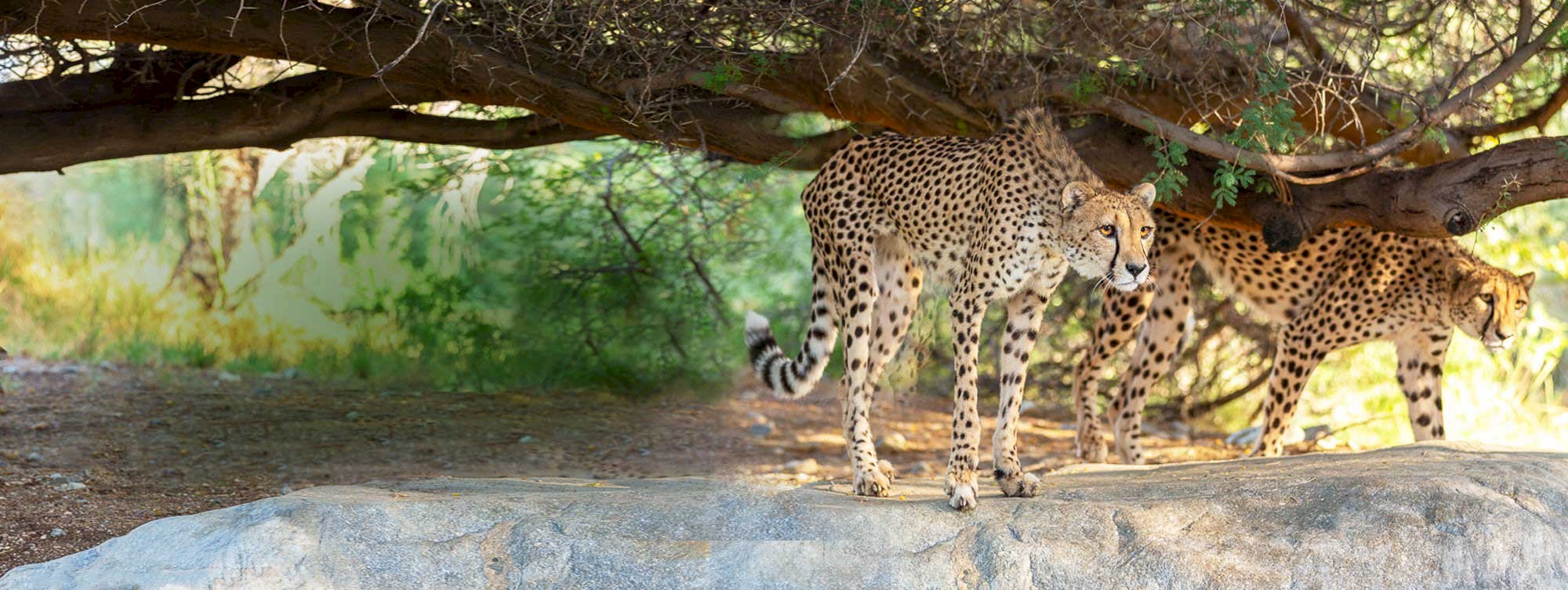The Living Desert Nature Trail Wildflower Season 2018/2019
February 27, 2019
The rains have come, transforming the Valley’s arid environs with a green veneer of ephemeral growth.
A mid-October rain coupled with continued warm temperatures perked up perennials like creosote (Larrea tridentata) and initiated the germination of annuals on The Living Desert’s Edmund Jaeger Nature Trail along drainages and in low lying areas. This initial rain prompted the season’s first pulse of scattered blossoms beginning in November.
Light rainfall in November and December helped sustain the first crop while gentle and more substantial rains in January coaxed out the second pulse of annuals. We found ourselves with scattered fully developed annuals in localized locations well ahead of average peak bloom time. Some Arizona lupines (Lupinus arizonicus) along the canyon section of the Nature Trail were waist high in January! Additional species have continued to germinate under favorably moist conditions.
The cooler than average temperatures of December and January have most likely inhibited the germination of certain annuals while allowing others to focus energies into vegetative growth resulting in larger plants capable of creating flower displays on a grander scale.
Warmer days will most certainly spur on a flush of added growth and flowers. Too much heat can rush the annuals through their bloom cycle in an effort to set as much seed as they can before soil profiles dry out too much. The dominant flower on the Nature Trail is brown-eyed primrose (Chylismia claviformis) covering wide swathes of ground as it did two years ago. The primroses are a favored food plant of the white-lined sphinx moth larva (Hyles lineata). 2017 saw an incredible irruption of larva along the Nature Trail. Will it happen again this year?
Feb. 15 update: WOW! 2.8 inches of rain fell on The Living Desert on Valentine’s Day bringing the park’s surface to life with rain splashed puddles and flowing rivulets. This is a huge amount for a one day storm! This ensures that the soil won’t be drying out any time soon. Time will tell the effects of this storm on the annuals already up and growing and the ones to come. Temperatures remain quite cool, a good ten degrees below average for this time of year.
The combination of the variables, moisture and temperature, create an infinite array of conditions resulting in no two wildflower seasons being the same.
The flowers are here, the scent of sand verbena (Abronia villosa) is in the air! It’s time to get out and have a look. A recent walk on the Nature Trail produced forty-seven species of plants in bloom. Below is a list of what’s being seen. Come out and see how many you can find, take your time and have a close look, some of these flowers are tiny. If you find any not listed please feel free to email me at kanderson@livingdesert.org and let me know what you found.
Enjoy the life!
| The Living Desert Nature Trail Current Bloom List | Bloom | |
| Asteraceae - Sunflower Family | ||
| Bebbia juncea var. aspera | Sweetbush | X |
| Encelia farinosa | Brittlebush | X |
| Malacothrix glabrata | Desert dandelion | X |
| Palafoxia arida var. arida | Spanish needle | X |
| Perityle emoryi | Rock daisy | X |
| Boraginaceae - Borage Family | ||
| Cryptantha angustifolia | Narrow-leaved forget-me-not | X |
| Cryptantha barbigera | Bearded forget-me-not | X |
| Cryptantha maritima | White-haired forget-me-not | X |
| Eucrypta chrysanthemifolia | Spotted hideseed | X |
| Pectocarya linearis | Slender comb-bur | X |
| Pectocarya recurvata | Arched-nutted comb-bur | X |
| Phacelia crenulata var. minutiflora | Notch-leaved phacelia | X |
| Phacelia distans | Wild heliotrope | X |
| Brassicaceae - Mustard Family | ||
| Brassica tournefortii* | Sahara mustard | X |
| Caulanthus lasiophyllus | Hairy-leaved mustard | X |
| Dithyrea californica | Spectacle pod | X |
| Lepidium lasiocarpum ssp. lasiocarpum | Sand peppergrass | X |
| Sisymbrium irio* | London rocket | X |
| Chenopodiaceae - Goosefoot Family | ||
| Chenopodium murale | Nettle-leaved goosefoot | X |
| Cucurbitaceae - Gourd Family | ||
| Brandegea bigelovii | Brandegea | X |
| Euphorbiaceae - Spurge Family | ||
| Chamaesyce polycarpa | Sand mat | X |
| Ditaxis lanceolata | Lance-leaved ditaxis | X |
| Fabaceae - Pea Family | ||
| Hoffmannseggia microphylla | Little-leaved rush pea | X |
| Lupinus arizonicus | Arizona lupine | X |
| Psorothamnus emoryi | Dye weed | X |
| Lamiaceae - Sage Family | ||
| Hyptis emoryi | Desert lavender | X |
| Loasaceae - Stick-Leaf Family | ||
| Mentzelia albicaulis | White-stemmed Blazing star | |
| Mentzelia affinis | Yellow comet | X |
| Malvaceae - Mallow Family | ||
| Eremalche exilis | Dune mallow | X |
| Sphaeralcea ambigua var. ambigua | Desert mallow | X |
| Nyctaginaceae - Four-O'Clock Familly | ||
| Abronia villosa | Sand verbena | X |
| Mirabilis laevis | Wishbone bush | X |
| Onagraceae - Evening Primrose Family | ||
| Camissoniopsis pallida ssp. hallii | Hall primrose | X |
| Chylismia cardiophylla ssp. cardiophylla | Heart-leaved primrose | X |
| Chylismia claviformis ssp. aurantiaca | Brown-eyed primrose | X |
| Eremothera boothii ssp. condensata | Woody bottle washer | X |
| Eulobus californicus | California evening primrose | X |
| Papaveraceae - Poppy Family | ||
| Eschscholzia minutiflora | Little gold poppy | X |
| Plantaginaceae - Plantain Family | ||
| Plantago ovata var. fastigiata | Wooly plantain | X |
| Polemoniaceae - Phlox Family | ||
| Gilia stellata | Star gilia | X |
| Polygonaceae - Buckwheat Family | ||
| Eriogonum inflatum | Desert trumpet | X |
| Pterostegia drymarioides | Fairy mist, Woodland threadstem | |
| Solanaceae - Nightshade Family | ||
| Nicotiana obtusifolia | Desert tobacco | X |
| Physalis crassifolia | Thick-leaved ground cherry | X |
| Urticaceae - Nettle Family | ||
| Parietaria hespera | Rock pellitory | X |
| Zygophyllaceae - Caltrop Family | ||
| Fagonia laevis | Smooth-stemmed fagonia | X |
| Larrea tridentata | Creosote | X |













